Berkeley’s cannoneers fire up for the Fourth
Tight-knit student, alumni group will help produce major fireworks shows
July 2, 2019
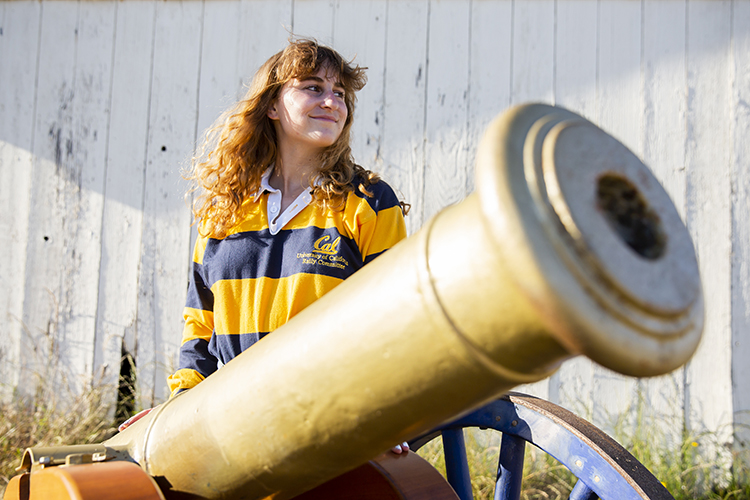
Allison Weber is one of Berkeley’s two cannoneers for 2019-2020. She will help produce Foster City’s July 4 fireworks show on a team led by a Berkeley alumna that includes 12 current and former Rally Committee members. (Photo by Brittany Hosea-Small)
If bursts of blue and gold explode this July 4th in your city’s night sky, chances are that UC Berkeley students and alumni are on the fireworks crew. And it all started with a cannon.
Of the estimated 100-plus members of the campus community, which includes alumni, who will help produce pyrotechnic spectaculars this week, about 40 were once Berkeley cannoneers — student guardians of the California Victory Cannon that’s fired from its platform on Tightwad Hill during Cal football games and at commencement.
A cannoneer’s one-year stint includes keeping secret the storage spot of the treasured campus icon, which has been stolen three times. A subset of the student Rally Committee, the close-knit cannoneers — about 70 in all — date back to 1963, when the cannon debuted at the Big Game rally.
“We’re a family that takes care of each other,” says Maya Goehring-Harris, Berkeley’s associate director of external relations for University Development and Alumni Relations, who was a cannoneer in the mid-1990s. “A lot of former cannoneers come back to the Bay Area to do fireworks shows. Once you’ve done one, they’re addictive. There’s a lot of physical labor, but when the crowd applauds, it’s a magical moment.”
Goehring-Harris, who will set off fireworks at Great America on July 5, describes Berkeley cannoneers as people who “care beyond themselves to do cool things for other people.”

Maya Goehring-Harris, a Berkeley staff member and alumna, is a licensed pyrotechnic operator responsible for handling the cannon’s explosives and making sure operations go safely. She’s also on duty at the annual Big Game bonfire. (Photo by Brittany Hosea-Small)
“Every time we fire the cannon, it’s about students celebrating being together, being alive, being fiery and hopefully winning the game. The July 4th jobs are similar,” says current cannoneer Allison Weber, a transfer student from Mammoth Lakes who’s majoring in conservation and resource studies. “Fireworks are loud, big and beautiful, making you feel like you are all those things, and somehow so small, as well.”
She’ll be on a fireworks crew in Foster City on July 4 and later in the week at the Colusa Casino Resort. The hours Weber logs will help move her closer to acquiring a pyrotechnic operator’s license, required to transport and handle explosives, from the Office of the State Fire Marshal.
Goehring-Harris, the primary licensee who oversees Berkeley’s cannon fire, says safety is the top priority. She makes sure the Bureau of Alcohol, Tobacco and Firearms’ regulations are obeyed at Berkeley and that protective gear — goggles, ear protection, non-flammable clothing, hard hats and closed-toe shoes — is worn to satisfy the Occupational Safety and Health Administration.
No projectiles are fired from Tightwad Hill, a well-known spot above California Memorial Stadium to watch football for free. Instead, the cannon’s smoky, fiery blasts occur when mini fireworks containing volatile flash powder and attached to the barrel’s tip are exploded via an electrical firing system.
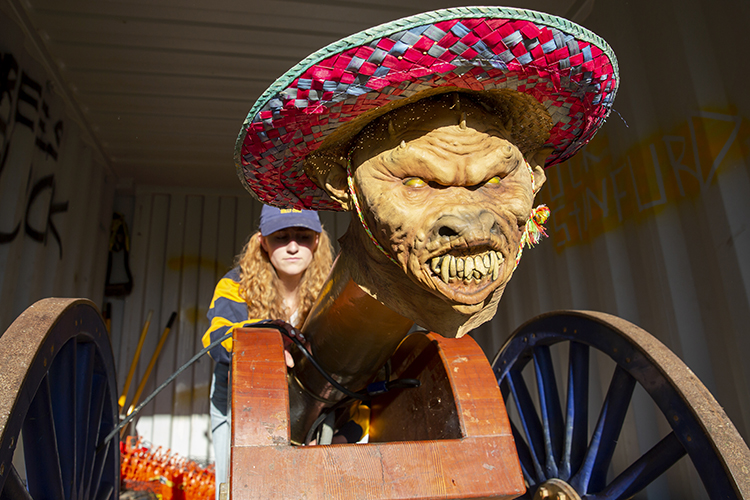
In its secret location many miles from campus, the cannon is secured with multiple locks and wears a frightening mask and colorful sombrero. (Photo by Brittany Hosea-Small)
A haven on Tightwad Hill
The 600-pound cannon, with its gold-painted barrel and blue wheels, was a gift from the Class of 1964. During the 1960s, cannons were the rage at many colleges and universities, and Berkeley students built theirs with San Francisco fire truck wheels, wood from a Napa winery and a barrel.
But while Berkeley’s cannon was a staple for years on the stadium’s sidelines, a serious accident at a Stanford University football game on Nov. 7, 1970, resulted in the old Pac-8 Conference banning pyrotechnics inside all its teams’ stadiums. Stanford’s cannon unexpectedly fired while being reloaded, propelling the ramrod — used to stuff flash powder into the barrel — about 130 yards toward the field. Two Stanford cannoneers were hospitalized with burns.
While other Pac-8 universities stopped using cannons, Berkeley’s was moved to Tightwad Hill by the Rally Committee, and its use resumed during games. At first, it sat on a platform built out of furniture from a freshman’s room in Bowles Hall, near the stadium. Later, a concrete and stone structure paid for by the cannoneers replaced the makeshift wooden one.
Ryan Dana, 2018-2019 chair of the Rally Committee and a former cannoneer, says that, while a cannon can be viewed as a military symbol, to him, Berkeley’s “displays the everlasting tradition of Cal students finding alternative solutions and never taking ‘no’ for an answer.”
Adds Weber, “It’s a student symbol. It was bought for students by students. It’s a source of comfort — all the Old Blues love to hear it. When it fires, it’s important to them.”
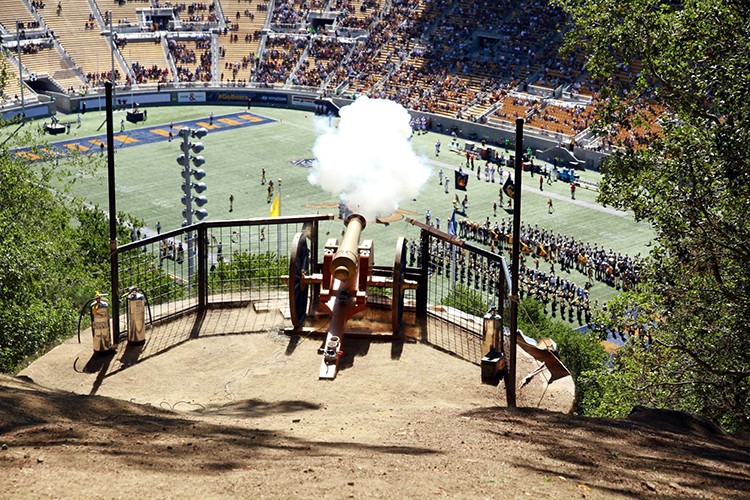
The cannon is flanked by fire extinguishers, just in case. It sits on a concrete and stone structure paid for by the cannoneers; its previous platform was a student’s desk. (Rally Committee photo)
Berkeley’s cannoneers first were recruited to work at fireworks shows by the now-defunct Thunderbolt Fireworks Co., which supplied burst charges for the cannon. Today, students and alumni typically participate in Pyro Spectaculars shows, either as paid crew leaders or volunteers, and some of them do it as part of the two-year apprenticeship required to earn a pyrotechnic operator’s license.
At Berkeley, staffer Goehring-Harris, who’s always loved fire — “I was the kid who played with matches in the bathtub when I was three or four,” she says — has the official title of campus pyrotechnician in her job description. Off campus, she’s been on and led countless fireworks crews — at San Francisco Giants and Oakland A’s games, in cities ranging from Monterey to Yountville to Martinez, and at New Year’s Eve shows, county fairs, Central Valley concerts, amusement parks and high school homecoming celebrations.
A good portion of Goehring-Harris’ helpers were once cannoneers and, a result, she says, “there are usually several blue and gold fireworks displays in a row.”
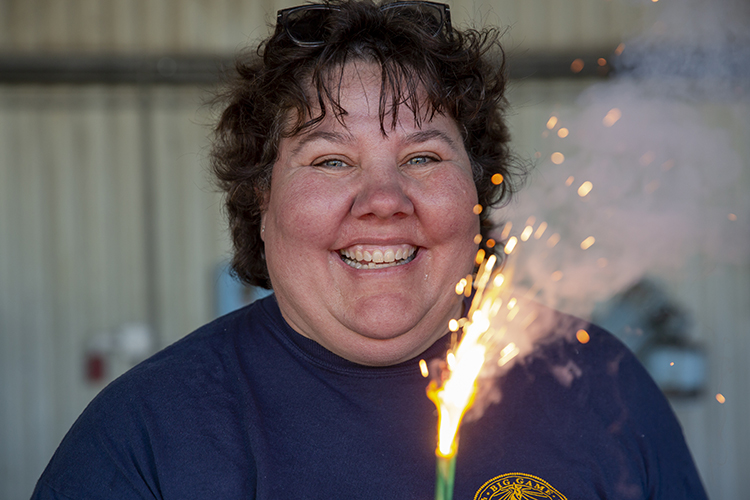
“I was the kid who played with matches in the bathtub. Fire has always been my thing,” says Maya Goehring-Harris, who oversees the cannon crew and has worked on — and led — many Fourth of July fireworks crews in the Bay Area and beyond. (Photo by Brittany Hosea-Small)
Body guards for Sturdy Gal
The job of cannoneer — two people have shared the duties since spring 1993 — isn’t an easy one. The pair rent a truck the night before a home football game, park it in Berkeley and, at dawn the next morning, pick up the crew and head to the cannon’s hiding spot, in another city.
Multiple locks on its storage unit are opened, and a door is raised to reveal a frightening mask, with long brown teeth and topped by a sombrero, on the cannon’s barrel. The cannon, in its “heavy beautifulness,” says Weber, is then loaded onto the truck and driven with care to Tightwad Hill. There, about 10 student helpers unload it, then slowly and carefully wheel the cannon downhill to its platform, using a strong rope.
“Never be in front of the cannon,” warns Weber.
The cannon crew creates a perimeter with yellow caution tape around the cannon. It’s meant to keep away fans from both teams, says Goehring-Harris, including those “sitting in the trees and drinking” who might try to wander too close.

No cannon balls fly from the California Victory Cannon. Mini fireworks containing volatile flash powder and attached to the barrel’s tip are exploded via an electrical firing system. (Photo by Brittany Hosea-Small)
An approximately 70-foot wire is stretched uphill from the charge on the cannon to a firing box. When a button on the box is pressed — cannoneers must watch carefully for touchdowns, field goals and a Cal victory — the charge is set off electrically.
“It’s eyes on the field,” says Weber. “You have to know what’s going on and pay attention.” The cannoneers — Weber shares duties with history major Berengar “Ber” Hebel, who’s entering his sophomore year — stand 30 feet apart, but both are poised for the very minute the Bears score.
When the cannon fires, “it’s so amazing,” says Weber. “You’re not usually ready for how loud it is, but it’s loud in a very exciting way.”
The cannon’s nickname is Sturdy Gal. Sturdy also is the name of the nearly 10-foot-tall sculptured bear on Piedmont Avenue next to the stadium parking structure, and it’s a word in the Cal song “Fight for California”: “Our sturdy Golden Bear/Is watching from the skies. …”
“Some people might see a masculine energy (in Berkeley’s cannon), or nothing at all,” says Weber, “but cannoneers know a strong woman when they see one. … We call her our Sturdy Gal because she … is beautiful and treasured, but also heavy and formidable.”
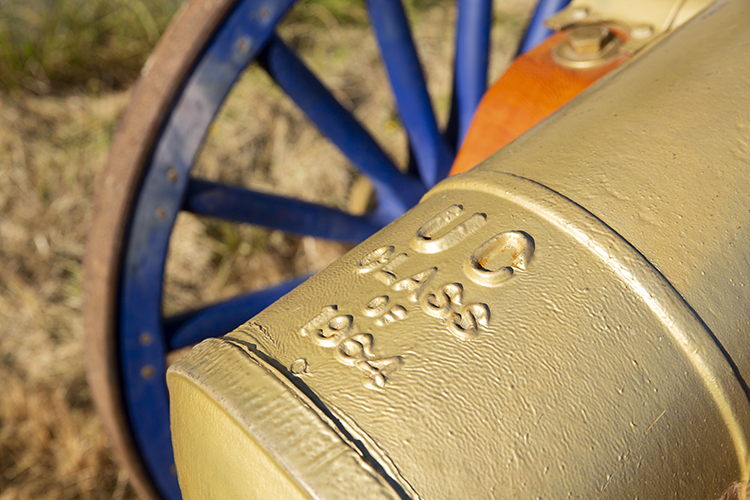
The cannon was a gift from the Class of 1964. There have been more than 70 cannoneers in its history. More than 40 of them will help with fireworks shows this week from coast to coast. (Photo by Brittany Hosea-Small)
‘Always stay with the cannon’
“Always stay with the cannon” is one of the cannoneer’s key rules. After all, Stanford swiped it twice in 1964 — from the stadium and, days later, from Berkeley’s student union. It was taken a third time from the Greek Theatre in 1972 by “some drunken Cal fraternity brothers,” according to the Rally Committee’s handbook.
In 2016, two cannoneers proved their dedication to the cannon on a rainy football Saturday, after the Bears had lost to Washington. The truck they were driving got stuck in the mud on Tightwad Hill, with the cannon on board.
“We were forced to sleep overnight on the hill, taking turns watching the cannon to make sure she was safe in the morning,” says Dana, last year’s Rally Committee chair, who was a cannoneer at the time. “To our surprise, about 10 of our closest Rally Committee friends brought us hot chocolate and our favorite board games that we all played in the back of the truck.”
That same camaraderie is evident on the Fourth of July, on fireworks crews like the one Berkeley alumna Masae Kubota supervises in Foster City. This year, she will have 22 helpers, 12 of them former Rally Committee members. Kubota, who graduated in 1974 with a psychology degree, has a pyrotechnic operator’s license and typically handles the Berkeley cannon’s explosives each year for the first home football game.
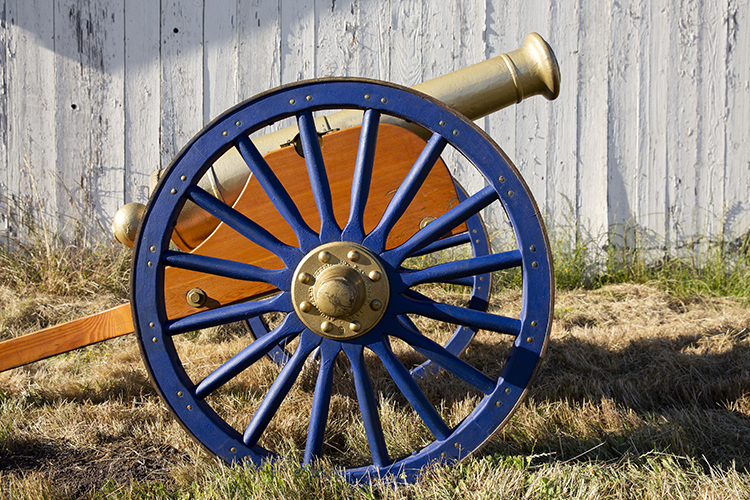
“It’s very celebratory and high energy,” cannoneer Allison Weber says of being on the crew for the California Victory Cannon, aka Sturdy Gal. “It’s also about rivalry and tradition and the stories we pass on.” (Photo by Brittany Hosea-Small)
Her Fourth of July starts at 5 a.m. and ends after the 9:30 p.m. show, near Foster City’s lagoon, where typically 30,000 to 40,000 people, two blocks deep, watch the fireworks. After the finale, “the first thing I yell is for everyone to take off their headphones so they can hear the crowd cheering,” says Kubota, who gifts her team with T-shirts, sweatshirts and a BBQ dinner.
Goehring-Harris says other locations for Fourth of July shows this week involving Berkeley students and alumni include New York City, for Macy’s annual spectacular, the California State Fair, the Marin and Colusa county fairs and the cities of Sacramento, Berkeley, Benicia and Martinez.
“I’ve been doing this in Foster City since 2011, and my crew would kill me if I decided not to do a show,” says Kubota. “And I wouldn’t have one for the new cannoneer to experience up close.”
Weber will join Kubota’s team on Thursday, but she’s already glimpsed the rare joy of setting the sky on fire at commencement last May, shortly after she became a cannoneer, and as a cannon crew helper prior to that.
“When it’s a night game, and a good game, and you’re on Tightwad Hill looking out over the whole Bay Area, and everything’s lit up, and the cannon fires perfectly and you see smiles, it’s so much fun,” says Weber. “Afterward, you realize you’ve had a very unique experience.”